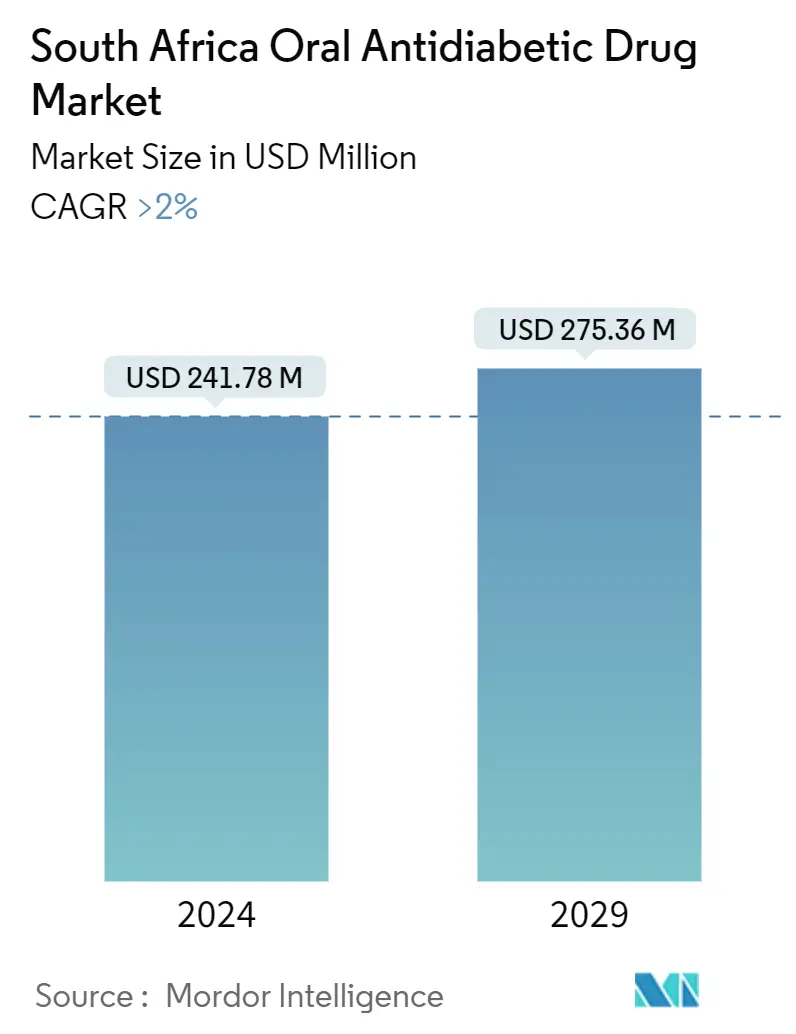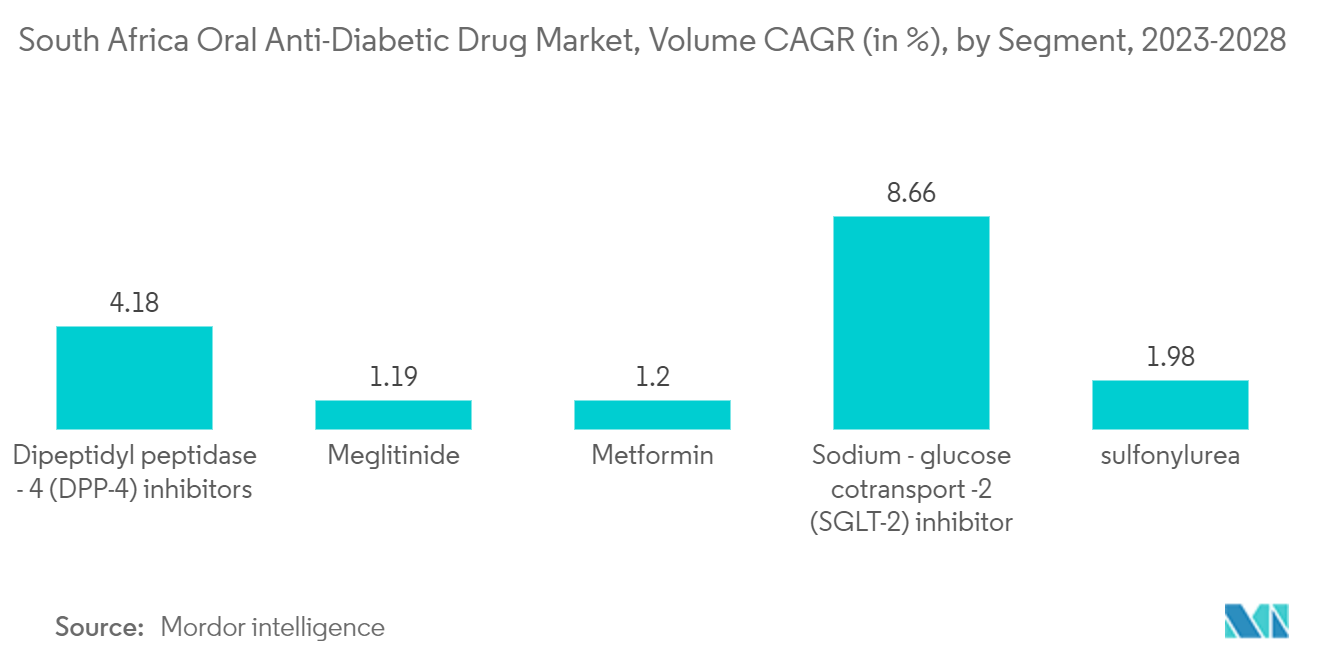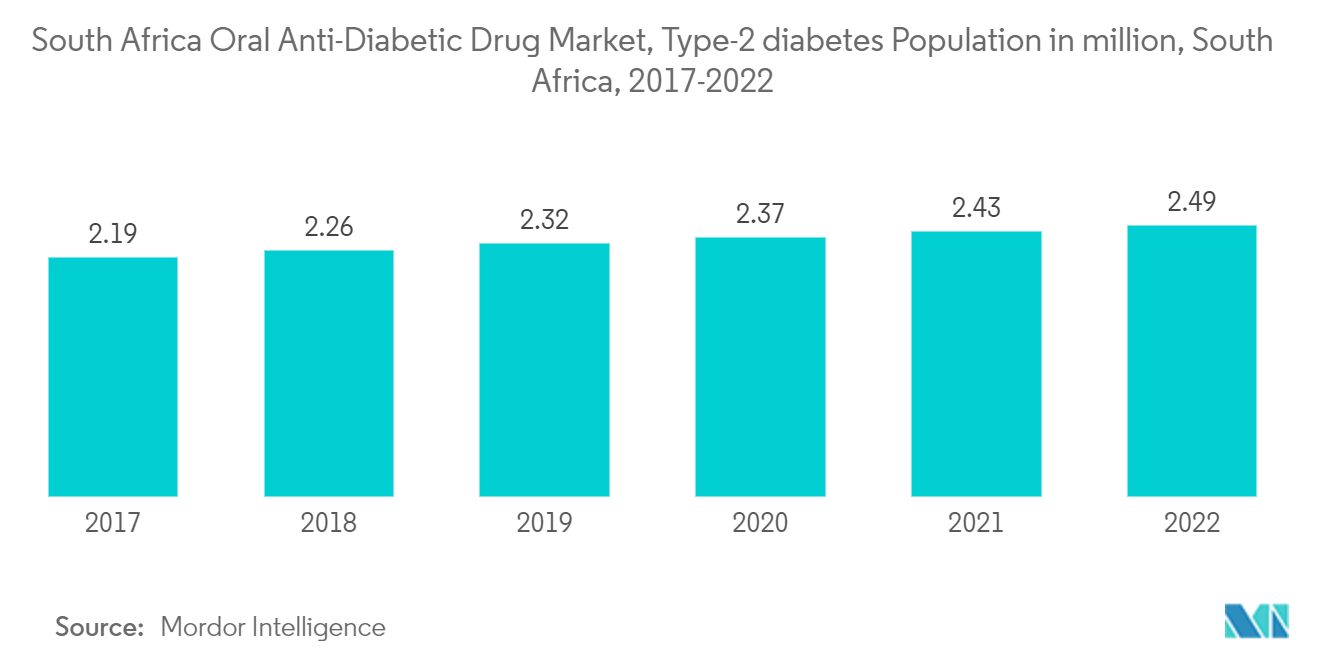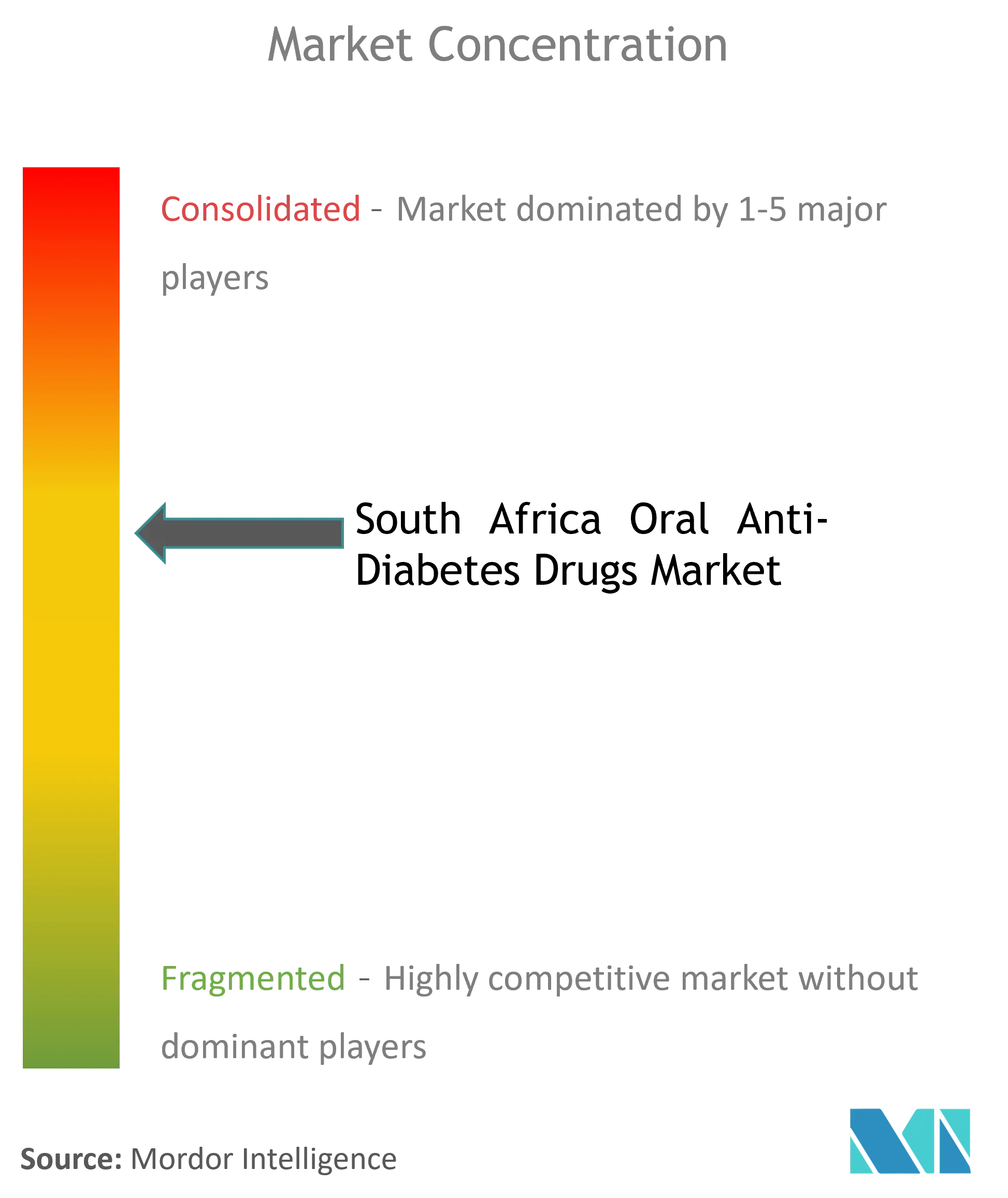South Africa Oral Antidiabetic Drug Market Size

| Study Period | 2019 - 2029 |
| Base Year For Estimation | 2023 |
| Forecast Data Period | 2024 - 2029 |
| Market Size (2024) | USD 241.78 Million |
| Market Size (2029) | USD 275.36 Million |
| CAGR (2024 - 2029) | 2.00 % |
Major Players
*Disclaimer: Major Players sorted in no particular order |
South Africa Oral Antidiabetic Drug Market Analysis
The South Africa Oral Antidiabetic Drug Market size is estimated at USD 241.78 million in 2024, and is expected to reach USD 275.36 million by 2029, growing at a CAGR of greater than 2% during the forecast period (2024-2029).
The COVID-19 pandemic favorably affected South Africa's market growth for diabetes medications. Diabetes problems, aberrant glucose variability, and increased blood glucose levels may be experienced by COVID-19-infected patients who have diabetes. In patients with either Type 1 (T1DM) or Type 2 diabetes mellitus (T2DM), the prevalence of diabetes significantly increased the severity and mortality of COVID-19, particularly about poor glycemic control. While, newly diagnosed diabetes (T1DM and T2DM) and newly diagnosed hyperglycemia have become more widely recognized in the context of COVID-19 and have been linked to poorer outcomes.
A patient's blood glucose should be checked frequently to prevent aggravation. Pharmaceuticals known as diabetic medications were created to stabilize and regulate blood glucose levels in people with diabetes. Diabetes is frequently treated using diabetic medications. Diabetes patients infected with SARS-CoV-2 during the COVID-19 pandemic may be treated with diabetic medications.
Numerous health issues are related to diabetes. Diabetes patients must make several daily adjustments to keep their blood glucose levels within acceptable ranges. For example, they may need extra insulin or consume more carbs. One of the main causes of illness, early mortality, and lost economic growth, diabetes is a growing healthcare burden for the nation. Obesity, a poor diet, and lack of exercise are the primary causes of the rise in newly diagnosed Type 1 and Type 2 diabetes cases.
Diabetes care products are increasingly being used, as evidenced by the fast-rising incidence, prevalence, and healthcare costs in industrialized nations. Additionally, the market is expanding due to the increased prevalence of diabetes and the deployment of insulin-delivery devices. Leading manufacturers are concentrating on technical advancements and creating cutting-edge items to capture a sizeable portion of the market.
South Africa Oral Antidiabetic Drug Market Trends
Sulfonylureas Segment Occupied the Highest Market Share in the South Africa Oral Anti-Diabetic Drugs Market in current year
In terms of revenue, the Sulfonylureas segment is anticipated to lead the South Africa Oral Anti-Diabetic Drugs Market and post a CAGR of over 1% during the forecast year.
Oral anti-diabetic medications have been made available globally and are advised for usage when type 2 diabetes therapy needs to be escalated along with lifestyle modification. Due to the wide variety of effectiveness, safety, and modes of action, oral medicines are frequently the first treatments employed in treating type 2 diabetes. Diabetes patients can minimize their complications risk and maintain their illness control using anti-diabetic medications. For the rest of their lives, people with diabetes may need to take anti-diabetic medications to manage their blood sugar levels and prevent hypo and hyperglycemia.
Oral anti-diabetic medications have higher acceptability than insulin, improving therapy adherence. They also have the advantages of easier control and cheaper cost. Diabetes is the disease with the quickest rate of growth in South Africa, where there are a lot of diabetic individuals. In South Africa, diabetes is becoming more common among people of all ages, which may be ascribed to an increase in the number of fat people, a poor diet, and a sedentary lifestyle.
Diabetes patients risk significant and even fatal consequences like heart attack, stroke, kidney failure, blindness, and lower limb amputation when undiagnosed or not appropriately controlled. These hurt the quality of life, increase healthcare spending, and make access to treatment more important. Growing knowledge of diabetic treatment, healthcare costs, and technology improvements are a few more variables fueling the increase in diabetes and obesity.
The youth are more likely to get diabetes early due to their younger ages and longer diabetes durations, which lowers their quality of life, reduces life expectancy, and raises societal healthcare expenditures. Educating the populace and promoting wise choices is one of the best strategies to reduce the prevalence of diabetes in South Africa.
South Africa is now pursuing this objective. The South African government has implemented a sugar tax as one of its preventive measures. The government is battling obesity and assisting individuals in making better-informed decisions by raising the price of sugary drinks and meals. A Diabetes Prevention Programme (DPP) was temporarily introduced in South Africa. The DPP seeks to include intervention therapies in a culturally appropriate setting.

The increasing Diabetes Population in South Africa is driving the market.
The numerous organizations in South Africa striving to aid people living with diabetes include Diabetes South Africa (DSA), the Society for Endocrinology, Metabolism, and Diabetes of South Africa (SEMDSA), and Youth with Diabetes (YWD). DSA is a nonprofit organization that focuses on enlisting volunteers to call for improved diabetes care, educates the public, and advocates to the government for better healthcare and more affordable facilities. SEMDSA also investigates the genetic roots and causes of diabetes. Additionally, this group advocates for high treatment standards and broad access to medications.
To reduce out-of-pocket costs and prevent patients from incurring more expenses, the organizations are advocating for allocating a larger budget earmarked for all facets of diabetes care. They are also offering a system for better coordination with the Council of Medical Schemes (CMS), the body in charge of reimbursement. The WHO Global Diabetes Compact prioritizes lowering obesity and expanding access to affordable medical care and medications for the early detection and management of diabetes. These measures are anticipated to raise public knowledge of diabetes monitoring and management, improving market prospects in future years.
The youth are more likely to get diabetes early due to their younger ages and longer diabetes durations, which lowers their quality of life, reduces life expectancy, and raises societal healthcare expenditures. As a result, the market has been driven by increased consumer demand for diabetes care devices and rising adoption rates. Educating the populace and promoting wise choices is one of the best strategies to reduce the prevalence of diabetes in South Africa. This objective is now being pursued by South Africa.
The South African government has implemented a sugar tax as one of its preventive measures. The government is battling obesity and assisting individuals in making better-informed decisions by raising the price of sugary drinks and meals. The Diabetes Prevention Programme (DPP) was started in South Africa. The DPP uses household surveys and meetings for at-risk people to incorporate intervention therapies into a culturally appropriate environment.
Maintaining blood glucose levels within a predetermined target range is one of the key goals of diabetes therapy. It may be done by combining meals with activity, lifestyle, and diabetes medications. Readings from blood glucose monitors give the data needed to choose the optimum diabetes care plan. The frequency with which people with diabetes who use insulin will check their blood glucose levels varies depending on various variables. People with type 2 diabetes who do not use insulin may not require as frequent blood glucose checks, but they may benefit from a period of systematic self-monitoring.

South Africa Oral Antidiabetic Drug Industry Overview
The South Africa oral anti-diabetes drug market is consolidated, with a few major manufacturers like Eli Lilly, AstraZeneca, Sanofi, and Janssen Pharmaceuticals having a global market presence. In contrast, the remaining manufacturers are confined to the other local or regional markets. Companies are focusing on innovations in diabetes drugs.
South Africa Oral Antidiabetic Drug Market Leaders
-
Astrazeneca
-
Astellas
-
Janssen
-
Eli Lilly
-
Sanofi
*Disclaimer: Major Players sorted in no particular order

South Africa Oral Antidiabetic Drug Market News
- FEB 2023: There has been a shortage of medication Ozempic for about six months. Novo Nordisk told activists the drug should be fully restocked again.
- May 2021: the Committee for Medicinal Products for Human Use (CHMP) recommended a change to the terms of the marketing authorization for the medicinal product Jalra by Novartis Europharm Limited. The updated summary of product characteristics (SmPC) will describe detailed recommendations for using this product.
South Africa Oral Antidiabetic Drug Market Report - Table of Contents
1. INTRODUCTION
- 1.1 Study Assumptions and Market Definition
- 1.2 Scope of the Study
2. RESEARCH METHODOLOGY
3. EXECUTIVE SUMMARY
4. MARKET DYNAMICS
- 4.1 Market Overview
- 4.2 Market Drivers
- 4.3 Market Restraints
-
4.4 Porter's Five Forces Analysis
- 4.4.1 Bargaining Power of Suppliers
- 4.4.2 Bargaining Power of Consumers
- 4.4.3 Threat of New Entrants
- 4.4.4 Threat of Substitute Products and Services
- 4.4.5 Intensity of Competitive Rivalry
5. MARKET SEGMENTATION
-
5.1 Oral Anti-diabetic drugs
- 5.1.1 Biguanides
- 5.1.1.1 Metformin
- 5.1.2 Alpha-Glucosidase Inhibitors
- 5.1.2.1 Alpha-Glucosidase Inhibitors
- 5.1.3 Dopamine D2 receptor agonist
- 5.1.3.1 Bromocriptin
- 5.1.4 SGLT-2 inhibitors
- 5.1.4.1 Invokana (Canagliflozin)
- 5.1.4.2 Jardiance (Empagliflozin)
- 5.1.4.3 Farxiga/Forxiga (Dapagliflozin)
- 5.1.4.4 Suglat (Ipragliflozin)
- 5.1.5 DPP-4 inhibitors
- 5.1.5.1 Onglyza (Saxagliptin)
- 5.1.5.2 Tradjenta (Linagliptin)
- 5.1.5.3 Vipidia/Nesina(Alogliptin)
- 5.1.5.4 Galvus (Vildagliptin)
- 5.1.6 Sulfonylureas
- 5.1.6.1 Sulfonylureas
- 5.1.7 Meglitinides
- 5.1.7.1 Meglitinides
6. MARKET INDICATORS
- 6.1 Type-1 Diabetic Population
- 6.2 Type-2 Diabetic Population
7. COMPETITIVE LANDSCAPE
-
7.1 COMPANY PROFILES
- 7.1.1 Takeda
- 7.1.2 Novo Nordisk
- 7.1.3 Pfizer
- 7.1.4 Eli Lilly
- 7.1.5 Janssen Pharmaceuticals
- 7.1.6 Astellas
- 7.1.7 Boehringer Ingelheim
- 7.1.8 Merck And Co.
- 7.1.9 AstraZeneca
- 7.1.10 Bristol Myers Squibb
- 7.1.11 Novartis
- 7.1.12 Sanofi
- *List Not Exhaustive
8. MARKET OPPORTUNITIES AND FUTURE TRENDS
** Subject To AvailablitySouth Africa Oral Antidiabetic Drug Industry Segmentation
Oral antihyperglycemic agents lower glucose levels in the blood. They are commonly used in the treatment of diabetes mellitus. The South Afric oral anti-diabetic drug market is set to witness a cagr of more than 2% during the forecast period. The South Africa oral anti-diabetic drug market is segmented into drugs. The report offers the market size in value terms in USD and Volume in terms of Units for all the abovementioned segments.
| Oral Anti-diabetic drugs | Biguanides | Metformin |
| Oral Anti-diabetic drugs | Alpha-Glucosidase Inhibitors | Alpha-Glucosidase Inhibitors |
| Oral Anti-diabetic drugs | Dopamine D2 receptor agonist | Bromocriptin |
| Oral Anti-diabetic drugs | SGLT-2 inhibitors | Invokana (Canagliflozin) |
| Jardiance (Empagliflozin) | ||
| Farxiga/Forxiga (Dapagliflozin) | ||
| Suglat (Ipragliflozin) | ||
| Oral Anti-diabetic drugs | DPP-4 inhibitors | Onglyza (Saxagliptin) |
| Tradjenta (Linagliptin) | ||
| Vipidia/Nesina(Alogliptin) | ||
| Galvus (Vildagliptin) | ||
| Oral Anti-diabetic drugs | Sulfonylureas | Sulfonylureas |
| Oral Anti-diabetic drugs | Meglitinides | Meglitinides |
South Africa Oral Antidiabetic Drug Market Research Faqs
How big is the South Africa Oral Antidiabetic Drug Market?
The South Africa Oral Antidiabetic Drug Market size is expected to reach USD 241.78 million in 2024 and grow at a CAGR of greater than 2% to reach USD 275.36 million by 2029.
What is the current South Africa Oral Antidiabetic Drug Market size?
In 2024, the South Africa Oral Antidiabetic Drug Market size is expected to reach USD 241.78 million.
Who are the key players in South Africa Oral Antidiabetic Drug Market?
Astrazeneca, Astellas, Janssen, Eli Lilly and Sanofi are the major companies operating in the South Africa Oral Antidiabetic Drug Market.
What years does this South Africa Oral Antidiabetic Drug Market cover, and what was the market size in 2023?
In 2023, the South Africa Oral Antidiabetic Drug Market size was estimated at USD 236.94 million. The report covers the South Africa Oral Antidiabetic Drug Market historical market size for years: 2019, 2020, 2021, 2022 and 2023. The report also forecasts the South Africa Oral Antidiabetic Drug Market size for years: 2024, 2025, 2026, 2027, 2028 and 2029.
South Africa Oral Antidiabetic Drug Industry Report
Statistics for the 2024 South Africa Oral Antidiabetic Drug market share, size and revenue growth rate, created by Mordor Intelligence™ Industry Reports. South Africa Oral Antidiabetic Drug analysis includes a market forecast outlook to for 2024 to 2029 and historical overview. Get a sample of this industry analysis as a free report PDF download.



